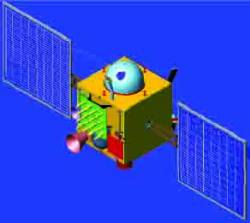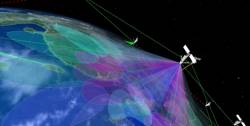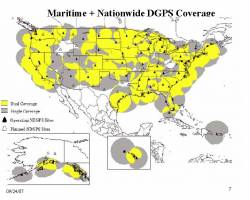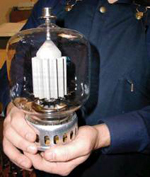NOAA Expands CORS Reference Sites

NOAA’s National Geodetic Survey (NGS) has recently added 43 GPS tracking sites into the Continuously Operating Reference Station (CORS) network overseen by the federal agency.
By Glen Gibbons
NOAA’s National Geodetic Survey (NGS) has recently added 43 GPS tracking sites into the Continuously Operating Reference Station (CORS) network overseen by the federal agency.
By Glen GibbonsSpain’s leading IT company, Indra, has begun a €1.5 million, 18-month project for the European Space Agency (ESA) to study the feasibility and definition of the European Geostationary Overlay Service (EGNOS) looking ahead towards a future multiconstellation regional system (MRS).
By Glen GibbonsAfter nearly a year of silence, Magellan has returned to the OEM GNSS space with the MB 500 GPS/GLONASS/SBAS dual-frequency board — reportedly the first of a series of new products by the long-standing brand.
By Glen Gibbons
Trimble has announced its new GNSS reference receiver — the Trimble NetR8 — for precise scientific and network infrastructure applications. The NetR8 reference receiver has 76 channels and supports GPS L1, L2, L2C and L5 signals as well as GLONASS L1/L2 signals.
Four additional channels are dedicated to tracking space-based augmentation systems
(SBAS), including Wide Area Augmentation System (WAAS) in North
America, European Geostationary Navigation Overlay System (EGNOS) in
Europe, Multi-functional Satellite Augmentation System (MSAS) in Japan,
Omnistar services and others.
The Raytheon Company has been awarded a $232.8 million contract for the system development and demonstration phase of the GPS-based Joint Precision Approach and Landing System (JPALS) program for shipboard applications.
JPALS provides all-weather shipboard landing capability to assist the Navy with pinpoint landing accuracy on aircraft carriers. The team, led by Raytheon Network Centric Systems, includes Rockwell Collins, Northrop Grumman, and SAIC.
By Glen Gibbons
SpectraTime has announced its receipt of a contract valued at approximately €4 million to supply rubidium space clocks for the Indian Regional Navigational Satellite System (IRNSS), a GNSS system that is under development by the Indian Space Research Organization (ISRO).
The IRNSS will consist of seven satellites, three in geostationary orbit and the other four in geosynchronous orbit. First launch of an IRNSS is currently expected in 2009. The system will transmit BOC(5,2) and BPSK signals at the L5 frequency (1176.45 MHz) and also in S-band.
By Glen Gibbons
From the perspective of consumers, the yearlong rise in commodity prices — from oil and natural gas to corn and wheat — has clouded the economic outlook. But for producers, including many GNSS manufacturers and service providers, those clouds have silver linings.
Recent financial reports from companies active in agricultural and natural resource markets bear this out. GNSS products used to guide and control equipment are in heavy demand as are real-time differential correction services, particularly those using global satellite-based systems.
By Glen Gibbons Iridium Satellite LLC graphic
Iridium Satellite LLC graphicThe Boeing Company has received a three-year, $153.5-million cost-plus-fixed-fee contract to continue its efforts to augment GPS for military applications by exploiting the Iridium low earth orbit (LEO) communications satellite system.
By Glen GibbonsA European initiative is seeking to link small and medium-sized enterprises (SMEs) in Asia and Europe through a series of one-on-one encounters between businesses operating in the aerospace and information and communication technology (ICT) sectors, with a special focus on Galileo-based satellite navigation applications.
By Glen GibbonsThe European Space Agency (ESA) has awarded a contract to IfEN GmbH to develop a “New Generation” receiver breadboard for use at the European Geostationary Navigation Overlay Service (EGNOS) Ranging and Integrity Monitoring Stations (RIMS).
The RIMS New Generation breadboard will be capable of receiving the new L2C and L5 signals, the Galileo E1, E5ab, and E6 signals and the GLONASS L1 signal in addition to GPS L1 and L2P signals.
By Glen Gibbons
The Nationwide Differential Global Positioning System (NDGPS) program has been salvaged from the political limbo in which it has resided for more than a year.
Following completion of an assessment by the U.S. Department of Transportation (DoT), the agency has decided to continue full NDGPS operations. Currently, 86 stations are operating with support from three federal agencies: the U.S. Coast Guard (USCG, 39 sites), the Army Corps of Engineers (9 site), and the DoT (38 sites operated and maintained by the USCG under contract).
By Glen Gibbons
Astrium Services and Allsat GmbH network+services have created a joint venture, AXIO-NET GmbH, to offer precise navigation and positioning services across Europe.
The companies, which formed a JV in September 2007 to operate the German ascos service, have created a trans-European brand — AXIO-NET — to extend the service, based on a network of reference stations that generate high-accuracy differential corrections of GPS and GLONASS satellite signals.
By Glen Gibbons Antiquated LORAN vacuum tube
Antiquated LORAN vacuum tubeThe Bush administration appears to have finally made a long-delayed decision to complete implementation of an enhanced LORAN (LOng RAnge Navigation) system to serve, in part, as a back-up to GPS.
Late in the drafting process of the Fiscal Year 2009 (FY09) budget proposal that went to Congress earlier this week (February 4), officials added language “migrating” the LORAN-C system from the U.S. Coast Guard (USCG) to the Department of Homeland Security’s National Protection and Programs Directorate (NPPD). A $34.5-million budget and 294 positions would take part in the migration.
By Glen Gibbons